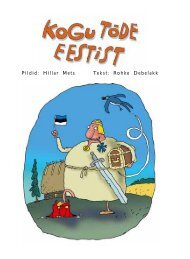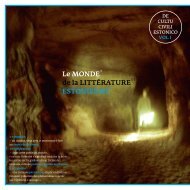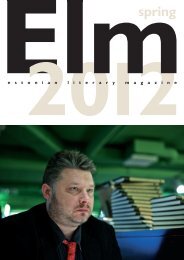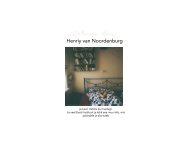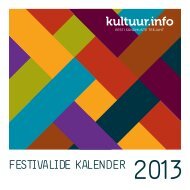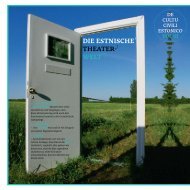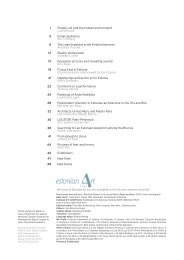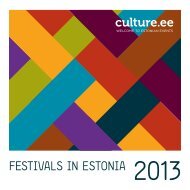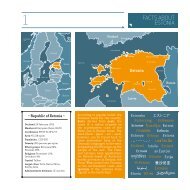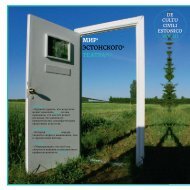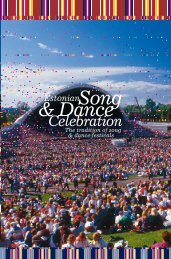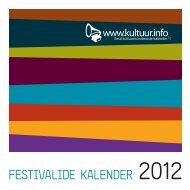Autumn 2013
Autumn 2013
Autumn 2013
Create successful ePaper yourself
Turn your PDF publications into a flip-book with our unique Google optimized e-Paper software.
When we walked home that evening, we<br />
saw a rare sight in Käsmu: a cat. The poor<br />
creature had many hairless patches, it was<br />
either wearing its summer clothes or had some<br />
kind of a disease, but it was definitely a cat. Its<br />
big brother the lion is an attribute of the patron<br />
saint of translators (and cats), St Jerome. If<br />
the attribute is present, so must in some way<br />
be the saint, as medieval people thought...<br />
Looking back now, we have no doubt whatsoever<br />
that the seminar was watched over by<br />
heavenly forces.<br />
On Monday morning, we woke early (including<br />
the above-mentioned lazybones), as we<br />
did not want to miss out on the glorious day.<br />
The guests of the day, Marek Tamm and Tiit<br />
Aleksejev, were already there, and the lectures<br />
began. The day was naturally dedicated to the<br />
topic of pilgrimages and crusades.<br />
Marek Tamm’s talk was entitled “What is a<br />
crusade? (Generally, and not forgetting Tiit<br />
Aleksejev’s novels in connection with the First<br />
Crusade)”. Marek explained how science sees<br />
the concept of crusades and pilgrimages. The<br />
interpretation of crusades has changed, e.g.<br />
their definition (and reflections in language, i.e.<br />
names), spatial and temporal boundaries,<br />
causes, motivations, even propaganda and the<br />
logistics of the time. The legal, social and even<br />
religious status of the crusaders was rather<br />
vague even in the Middle Ages. The concept<br />
of truth is no help either: it is something useful<br />
for society. All this means that there is no clarity<br />
about what a crusade in fact was. It is better<br />
to ask: what was a crusade like? It was certainly<br />
a ‘holy war’, a pilgrimage and was supported<br />
by the Pope. In any case, the crusades<br />
were sufficiently vague to enable medieval<br />
chroniclers and modern historian great latitude.<br />
Tiit Aleksejev arrived with a bagful of books.<br />
Not for the sake of sport, but he recommended<br />
and showed us books that he deemed important<br />
as background material for translating the<br />
novels. About medieval sources, he mentioned<br />
that later materials could be more truthful than<br />
contemporary chronicles, considering the<br />
religious fervour accompanying the pilgrimages.<br />
However, most of what we know comes<br />
from various narratives, and the chroniclers<br />
always had their own attitudes and points of<br />
view. Chronicles must be deciphered if the interests<br />
of the chroniclers and those who commissioned<br />
them differ. Every line written about<br />
the crusades is thus reconstruction and fiction.<br />
History prefers to describe great deeds by<br />
great men, whereas some writers are fascinated<br />
by small deeds of great men or the great<br />
deeds of little men. Tiit also mentioned his own<br />
pilgrimage to the Holy Land. He introduced the<br />
art of medieval warfare, describing in detail military<br />
equipment, strategy and how every battle<br />
increased the self-confidence and professionalism<br />
of the surviving soldiers of all ranks.<br />
In the afternoon, we continued discussing<br />
translation issues of The Pilgrimage, such as<br />
transcription; especially in personal and place<br />
names, we were not sure whether to use Latin,<br />
Greek or some other language. Some cultures<br />
traditionally use their own versions of great<br />
European characters and names of the cities.<br />
We discussed the problems of intertextuality,<br />
the most interesting of which was the<br />
emergence of “the culture of preachers” in the<br />
novel: using Biblical texts and Catholic liturgy<br />
in the form of oral tradition, not quoted word<br />
for word, but relying on memory. Quotations<br />
were largely used when they served the user’s<br />
purpose. The mere fact that a quotation came<br />
from the Bible afforded it definite authority,<br />
although only few knew its precise meaning.<br />
The translators had found interesting solutions<br />
in different languages for the author’s “linguistic<br />
inventions”, i.e. creative swear words, onomatopoetic<br />
expressions or characters’ peculiar<br />
language usage. We learned a great deal<br />
about style as well, how to keep it as close to<br />
the original Estonian as possible. We finally<br />
tortured the author with minutely detailed<br />
questions, which came from too much pondering<br />
the text, and together we achieved some<br />
sort of balance between reality and fiction,<br />
keeping in mind the interests of the average



